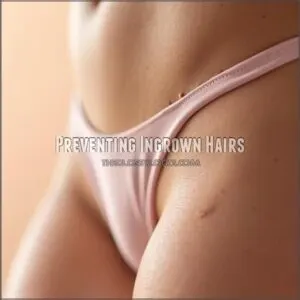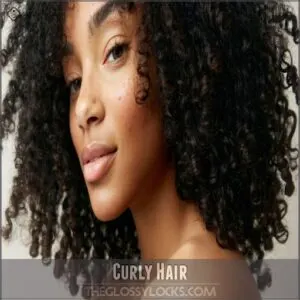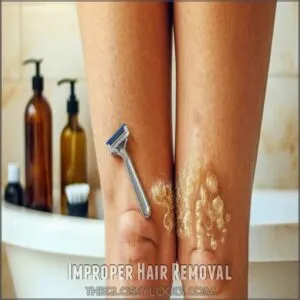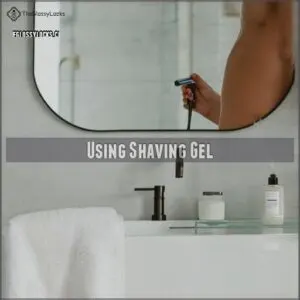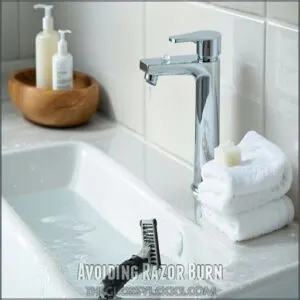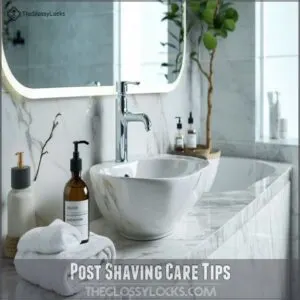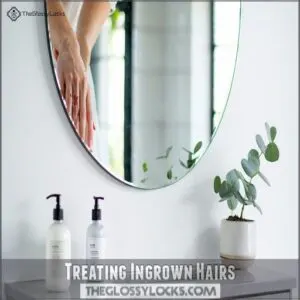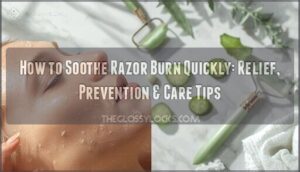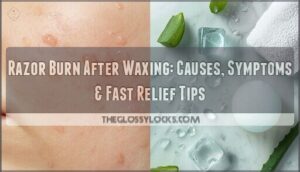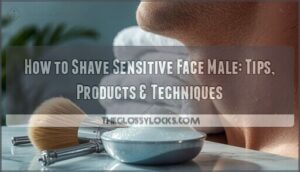This site is supported by our readers. We may earn a commission, at no cost to you, if you purchase through links.
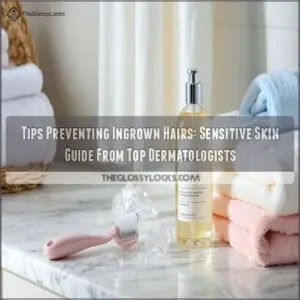
For "tips preventing ingrown hairs sensitive skin," start with gentle exfoliation 2-3 times a week. This sweeps away dead skin, preventing trapped hairs.
Hydrate with a light, fast-absorbing moisturizer, especially after hair removal.
Loose, breathable clothing is your skin’s best friend – ditch those tight jeans for a while!
And remember, a sharp razor and proper technique are key.
There’s more to uncover about taming those pesky ingrown hairs…
Table Of Contents
- Key Takeaways
- Preventing Ingrown Hairs
- Causes of Ingrown Hairs
- Reducing Ingrown Hairs
- Shaving Techniques Matter
- Post Shaving Care Tips
- Treating Ingrown Hairs
- Frequently Asked Questions (FAQs)
- How can I stop being prone to ingrown hairs?
- Why am I so prone to ingrown hairs down there?
- How do I stop picking ingrown hairs?
- Why do I get ingrown hairs so easily?
- Does diet impact ingrown hair development?
- Can certain fabrics worsen ingrown hairs?
- Are there specific ingredients to avoid in skincare?
- How often should I replace my razor blade?
- Is laser hair removal suitable for all skin tones?
- Conclusion
Key Takeaways
- Exfoliate gently 2-3 times a week to remove dead skin cells and prevent hair from getting trapped under the surface.
- Moisturize after hair removal with a fast-absorbing lotion containing soothing ingredients like allantoin or alpha-hydroxy acids.
- Shave with the grain using a sharp blade and shaving gel designed for sensitive skin to reduce irritation and ingrown hairs.
- Wear loose, breathable fabrics like cotton after hair removal to minimize friction and let skin heal naturally.
Preventing Ingrown Hairs
You’ll find relief from those pesky ingrown hairs by following dermatologist-approved prevention methods that work with your sensitive skin.
Whether you’re dealing with razor bumps on your legs or irritation in your bikini area, these proven techniques will help you maintain smooth, bump-free skin without the discomfort.
Exfoliating Regularly
To keep those pesky ingrown hairs at bay, you’ll want to make exfoliation your skin’s best friend.
Use gentle scrubs with circular motions 2-3 times weekly to clear dead skin cells that trap hair beneath the surface. Choose physical exfoliants designed for sensitive skin, focusing on areas prone to ingrowns.
For more information on ingrown hair treatments, consider consulting a dermatologist for personalized advice. This simple skin care routine promotes hair follicle health and helps your razor glide smoothly during shaving.
Hydrating Skin
Keeping your skin’s barrier hydrated acts as your first line of defense against pesky ingrown hairs. Apply a fast-absorbing moisturizer with soothing allantoin after hair removal to reduce redness and inflammation.
For best results, look for hydrating lotions containing alpha-hydroxy acids, which help trapped hairs break through while maintaining skin hydration. Using ingrown hair products can also aid in preventing ingrown hairs and reducing irritation.
Coconut oil offers natural moisturizing benefits that soften hair and prevent irritation.
Avoiding Tight Clothing
Your skin needs room to breathe after hair removal, so ditch those tight clothes for at least 24 hours.
Wearing loose, breathable fabrics reduces friction and skin irritation, especially in sensitive areas prone to ingrown hairs.
Choose cotton or moisture-wicking materials over synthetic fibers, and let your skin heal naturally. If you’re dealing with sensitive skin, baggy is better than body-hugging until irritation subsides.
Causes of Ingrown Hairs
You’ll likely experience ingrown hairs when your hair grows back into the skin instead of rising up, especially if you have curly hair or use improper hair removal techniques.
Dead skin cells can block your hair follicles and trap the hair underneath your skin, making the problem even worse in areas where you frequently remove hair.
Curly Hair
For those with curly locks, your hair follicle health plays a bigger role in preventing ingrown hairs than you might think.
Natural curl patterns make hair more likely to bend back and re-enter the skin after shaving, leading to those pesky bumps.
People with curly hair face this challenge more often, especially in areas like the beard, where tight coils can easily twist back into the skin.
Improper Hair Removal
While curly hair naturally tends to grow inward, hair removal mistakes can make anyone prone to ingrowns. Understanding ingrown hair causes is essential to prevent them.
Common shaving technique flaws include pressing too hard, going against hair growth, or using dull razors. These ingrown hair triggers create sharp, jagged ends that easily pierce your skin.
Rushing through the process or skipping shaving cream leads to razor burn causes like friction and skin irritation factors you’d rather avoid.
Dead Skin Cells
Dead skin cells can be sneaky troublemakers regarding ingrown hairs.
Your skin’s natural cell turnover process leads to cellular buildup, which can trap hair beneath the surface. Think of it like a traffic jam – dead cell removal through regular skin exfoliation keeps those pathways clear.
By incorporating gentle skin purging into your care routine, you’ll boost skin renewal and greatly reduce your chances of ingrown hair formation.
Reducing Ingrown Hairs
You’ll find it easier to manage those pesky ingrown hairs by switching to gentler hair removal methods like trimming or using chemical treatments.
If you’re looking for a more permanent solution, consider professional options like laser hair removal, which can substantially reduce your chances of developing ingrown hairs over time, such as waxing.
Trimming Hair
Proper trimming techniques can be your best defense against those pesky ingrown hairs. Here’s how to keep your skin smooth and happy:
- Leave a bit of stubble instead of going completely bare
- Use a single-blade razor to avoid cutting too close
- Keep your razor sharp and clean for safer trimming
- Follow your hair’s natural growth direction
- Give your skin a break between trimming sessions
You’ll notice fewer bumps and irritation with these simple trimming tweaks.
You can achieve smooth skin by following these guidelines.
Chemical Hair Removal
Looking for a gentler way to prevent ingrown hairs?
Chemical hair removers work by breaking down hair proteins right at the skin’s surface.
These depilatory creams are particularly effective for sensitive areas prone to razor bumps.
Just remember to do a patch test first, choose formulas with soothing ingredients like aloe vera, and follow the instructions carefully.
Hair dissolvers can provide smoother results than traditional shaving methods.
Waxing and Laser
Beyond creams, consider longer-term hair removal solutions.
Waxing techniques, while temporarily effective, can irritate hair follicles, increasing ingrown hair risks.
Laser hair removal offers a more permanent solution. It targets the hair follicle, minimizing future growth and consequently ingrown hairs.
For sensitive skin, explore gentle waxing aftercare and laser hair removal options.
Shaving Techniques Matter
You can minimize ingrown hairs by using proper shaving techniques. This includes prepping your skin and using the right tools and products.
Using Shaving Gel
Switching to proper shaving techniques? Start by using shaving gel—it locks in moisture, letting razors glide effortlessly over your skin.
This prevents razor burn and also reduces ingrown hairs by minimizing irritation. Look for gels formulated for sensitive skin with hydration-boosting ingredients like glycerin.
Hydrated, smooth skin is easier to shave and far less prone to ingrowns. For ideal results, understanding sensitive skin care is vital in preventing ingrown hairs and achieving a smooth shave.
Shaving Cream Benefits
Shaving cream for sensitive skin makes your shave smoother and reduces irritation while boosting foam enhancement. It works to lock in moisture and soften hair, improving razor protection.
Using a shaving cream can greatly enhance the shaving experience.
For the best results:
- Pick a cream designed for sensitive skin.
- Apply a thick layer evenly.
- Always shave with the grain.
- Rinse and moisturize to keep skin smooth.
Avoiding Razor Burn
To prevent razor burn, focus on razor care and always use sharp, clean blades.
Glide with a generous layer of shaving gel, especially on sensitive areas.
Rinse thoroughly and apply an after shave balm for skin soothing and burn relief.
Consistent sensitive skin care helps prevent ingrown hairs and irritation, keeping shaving sensitive skin smooth and comfortable.
Post Shaving Care Tips
Taking care of your skin after shaving is essential to prevent irritation and minimize the chances of developing ingrown hairs.
Simple steps like applying a warm compress, using an anti-ingrown hair serum, and gently exfoliating can keep your skin smooth and healthy.
Applying Warm Compresses
Beyond a good shave, consider warm compresses for skin soothing and ingrown hair prevention.
Heat therapy from warm wraps offers compress benefits, including skin relief and softening the skin, making it less prone to ingrown hairs.
Understanding ingrown hair causes is important for effective prevention and treatment.
This simple step in your sensitive skin care routine can prevent ingrown hairs and offer skin irritation relief, a practical ingrown hair remedy.
This gentle approach maximizes comfort and minimizes irritation.
Anti Ingrown Hair Serum
After softening your skin with a warm compress, boost ingrown hair prevention by using an anti-ingrown hair serum. These serums are packed with active ingredients formulated to soothe irritation and keep hairs from curling back.
Here’s how to use them effectively: Many skincare experts recommend using a high quality anti ingrown serum to achieve maximum results.
- Apply twice daily for maximum effectiveness.
- Follow it with a moisturizer.
- Watch for redness (possible side effect).
- Stick to your post-serum routine!
Gentle Exfoliating
Lightly exfoliate sensitive skin 3 days after shaving to prevent ingrown hairs. This gentle exfoliation helps remove dead skin cells and clears the way for hairs to grow correctly.
Use gentle scrubs or a soft exfoliating tool, like a washcloth, as part of your skin care routine. Avoid harsh body polishing or facial massage to minimize irritation and maintain skin smoothing.
For ingrown hair prevention, gentle exfoliation is key.
Treating Ingrown Hairs
So, you’ve got an ingrown hair—it happens. Here’s how you can treat it and get some relief.
Medical Treatments Available
For persistent ingrown hairs, medical treatments offer stronger solutions. Topical or oral antibiotics can combat infection, while laser hair removal targets the skin growth pattern for long-term reduction.
Chemical peels and microdermabrasion exfoliate, encouraging proper hair removal and preventing skin follicles from trapping hairs. Phototherapy can also address skin inflammation related to ingrown hairs.
- Consult a dermatologist for personalized advice.
- Laser therapy offers a lasting solution.
- Skin peels promote healthy skin follicles.
Steroid Creams
Beyond general medical approaches, steroid creams offer targeted skin relief.
They reduce inflammation, a key trigger for ingrown hairs, especially on sensitive skin.
This topical treatment calms skin irritation and minimizes hair growth disruptions.
| Benefit | How it Works | For Whom? |
|---|---|---|
| Inflammation Reduction | Calms irritated skin | Sensitive skin |
| Skin Relief | Soothes redness | Post-shaving care |
| Hair Growth Control | Minimizes bumps | Ingrown hair prevention |
| Prevent Ingrown Hairs | Supports healthy follicles | All skin types |
| Cream Benefits | Moisturizes, protects | Dry, irritated skin |
They are particularly useful for post-shaving care and ingrown hair prevention, helping to minimize hair growth disruptions.
Acne Medications
Acne medications, like tretinoin, can often prevent ingrown hairs by softening the skin.
Benzoyl peroxide, found in some over-the-counter acne medications, may also help treat razor bumps.
These medications can be beneficial, similar to how shaving cream and gel help skin by creating a barrier during shaving.
Hydroquinone cream can reduce discoloration from previous ingrown hairs, while steroid creams can lessen inflammation.
Always consult a dermatologist before using prescription acne medications or steroid creams for ingrown hairs.
Oral Antibiotics
For stubborn infections, oral antibiotics can help clear bacterial infections and reduce skin inflammation. However, there’s the sticky wicket of antibiotic resistance.
Your doctor might first suggest topical antibiotics for infection control.
To prevent ingrown hairs, understanding shaving techniques is important for sensitive skin.
Chat with them about the potential medication side effects of oral antibiotics before starting a course. This approach tackles those pesky skin infections while minimizing the risk of antibiotic resistance.
Frequently Asked Questions (FAQs)
How can I stop being prone to ingrown hairs?
Ingrown hairs affect many. Regularly exfoliate with a gentle scrub, shave with the grain using a sharp razor, and moisturize to prevent them.
Why am I so prone to ingrown hairs down there?
Curly or coarse hair, common in the pubic area, is more likely to curl back into the skin. Close shaving and tight clothing can also contribute to ingrown hairs there.
How do I stop picking ingrown hairs?
Resist the urge to pick—it’s like scratching an itch that only makes things worse.
Instead, exfoliate gently, use a warm compress to ease discomfort, and let the trapped hair work its way out naturally over time.
Why do I get ingrown hairs so easily?
You’re prone to ingrown hairs because factors like shaving too closely, clogged hair follicles, or coarse, curly hair make it easier for strands to grow sideways into your skin.
Dead skin buildup or tight clothing doesn’t help either, and these are also clogged hair follicles issues.
Does diet impact ingrown hair development?
There’s no solid proof that diet directly causes ingrown hairs, but staying hydrated, eating anti-inflammatory foods like leafy greens, and avoiding too much sugar can help maintain healthy skin.
Making ingrowns less likely.
Can certain fabrics worsen ingrown hairs?
Tight, non-breathable fabrics like polyester or spandex can trap sweat and irritate hair follicles, making ingrown hairs worse.
Opt for loose, natural fabrics like cotton to keep your skin comfortable and reduce friction.
Are there specific ingredients to avoid in skincare?
Your skin thrives on gentle care, so skip harsh ingredients like alcohol, synthetic fragrances, and sulfates.
They strip moisture and trigger irritation, leaving sensitive skin vulnerable.
Stick to calming, hydrating products with aloe, glycerin, or ceramides.
How often should I replace my razor blade?
Swap out your razor blade every 5-7 shaves or when it feels dull.
A sharp blade prevents tugging, irritation, and ingrown hairs.
If you shave daily, aim for a fresh blade weekly.
Is laser hair removal suitable for all skin tones?
Think of laser hair removal like a custom-fit suit—it’s designed to work differently for everyone.
Recent advancements make it safe for all skin tones, but darker skin benefits most from Nd:YAG lasers due to lower risks.
Conclusion
Did you know that about 60% of people with curly or coarse hair struggle with ingrown hairs?
Protecting sensitive skin doesn’t have to be complicated. Start by exfoliating gently, moisturizing daily, and wearing loose clothing.
Use proper shaving techniques, like shaving with the grain and using gel or cream. Look into professional options like laser hair removal if issues persist.
Following these tips for preventing ingrown hairs on sensitive skin will help keep your skin smooth and irritation-free.
- https://www.healthline.com/health/beauty-skin-care/ingrown-hair-products
- https://my.clevelandclinic.org/health/diseases/17722-ingrown-hair
- https://www.vogue.com/article/ingrown-hair-treatments
- https://www.byrdie.com/best-ingrown-hair-treatments-4774468
- https://www.allure.com/gallery/best-ingrown-hair-treatments

